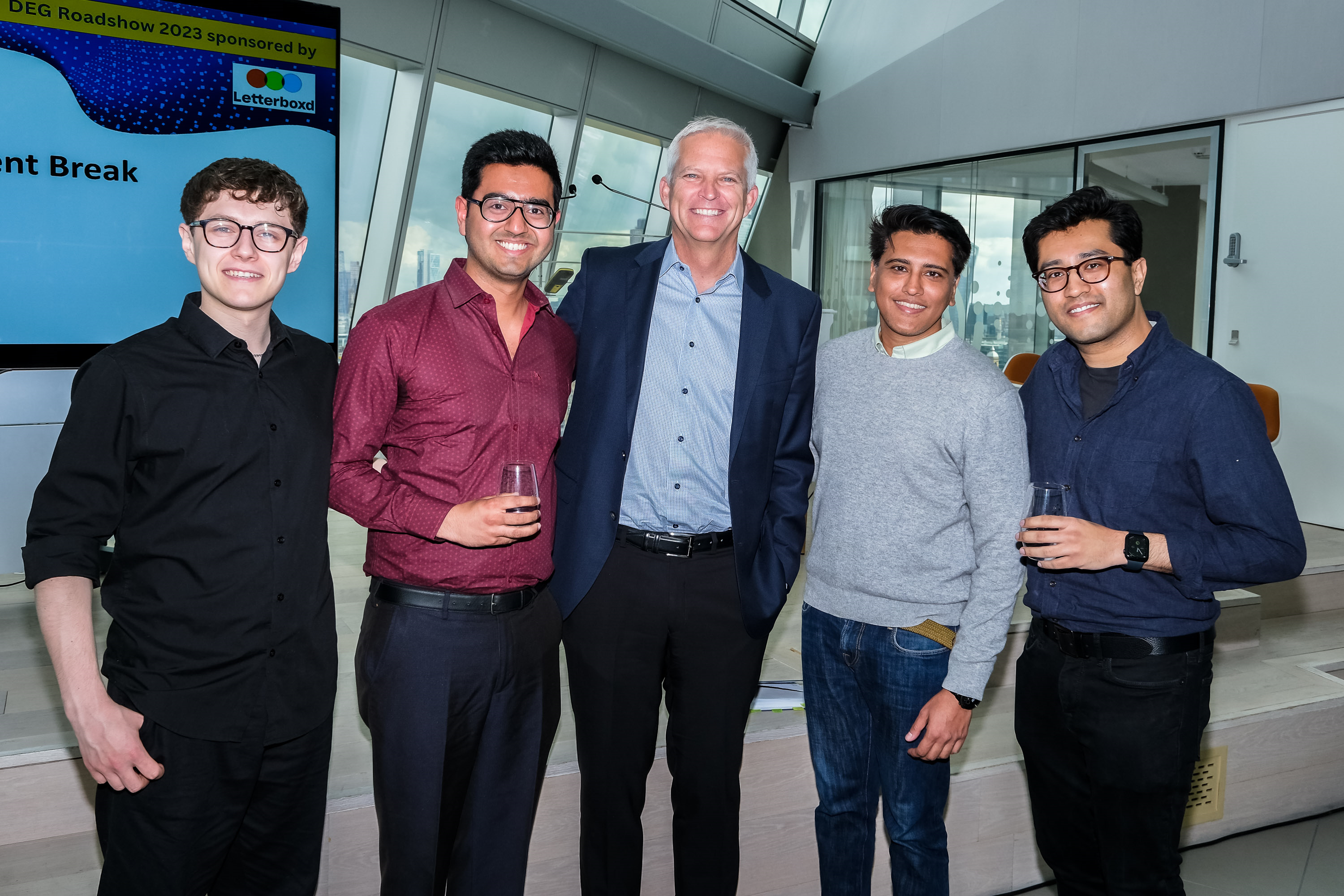Students from the National Film and Television School joined us on May 11th for the annual DEG Roadshow. The Marketing, Distribution, Sales & Exhibition (MDSE) students kindly shared their top ten takeaways from the London leg of the Roadshow.

Photo: Left to right: Thomas Coupland, Bhavesh Joshi, Bob Buchi (Paramount Pictures), Dinesh Parasurum, Aditya Chakraborty
Return of Cinema
Theatrical is poised for a big return in 2023. Jeremy Enos (SVP, WW Market Intelligence and Strategic Planning, Paramount Pictures) shared that a study conducted showed action and superhero are key genres drawing crowds to the theatres. In addition, thriller, animation, drama and comedy have seen incremental increases in in-home consumption. This is reflected in the studio’s theatrical slate.
Experimenting with Windowing
Studios are experimenting with different windowing to determine which model reaps maximum revenue. Panellists (covering ‘Retail Perspectives’), however, opined that the varying release approaches only confuse consumers who are uninformed about the availability windows. A suggestion was for companies to synchronize their efforts and collaborate more closely, aiming to establish a standardized windowing system. By achieving this, customers will better understand the timeframes required for content to become accessible across diverse distribution channels, thereby boosting their involvement in transactions.
SVOD
SVOD is demonstrating signs of stabilising and slowing in growth for the first time ever, whilst AVOD, TVOD, and FAST services grow.
FAST on the rise
FAST and AVOD are struggling to take off in the UK, with only 1 in 9 of the population and 1 in 4 in the US. However, it is forecasted to take 5% of global video advertising revenue by 2027, with a projected value of $13 Billion. In addition, a Kanter survey found that 46.2% of UK VOD consumers wouldn’t mind watching ads to access cheaper prices, further supporting the rise of AVOD and FAST.
Potential to further drive home entertainment
Consumers have shown a willingness to spend on titles/content with which they are attached, such as ‘Mandalorian’, ‘Stranger Things’. There is a potential to feed the consumer appetite through a “collector proposition” and creating “shared moments” for consumers either through traditional (eg. brick-and-mortar stores such as HMV) or virtual touchpoints.
Catalogue titles have always been a major part of the Home Ent. business. However, it is seen that the catalogue needs to be more under-indexing on viewership as compared to previous years. However, despite this, there is a 2-11% growth forecast for the Home Ent. market, highlighting that more consumer behaviour shifts are underway. Much of the forecasted growth is attributed to new releases such as titles mentioned above.
Gaming
Gamers are among the most valuable holistic consumers. They are similar from country to country, additionally watching more tv, films, and going to the cinema more than anyone else. This is why gaming is a key sector in the global M&E portfolio.
Rising popularity of Smart TV
Smart TV has gained significant popularity, especially in markets such as US, UK, Japan, and Brazil, and could evolve the TV from its current medium. It is interesting to see, however, that in countries like Japan, mobile phones and laptops represent the preferred viewership method, while Brazil seems to prefer a balance between mobile phones and smart TVs – highlighting the vast differences in cultural engagement between regions. In addition, hardware companies (and DEG) are trying to understand consumer habits via Smart TV OS. Can it be the browser of the future? This spells opportunities for collaborations with hardware companies to understand how companies can curate top-of-mind recall and visibility through placements of their brands and products.
Piracy
Piracy remains a concern for the industry, which hopes that making content more easily available to consumers will deter them from looking to illegal downloads. The paradox is that digital releases provide pirates pristine, 1:1 copies of films to distribute. In contrast, theatrical releases provide poor-looking copies, likely a deterrent for that fact alone.
Strikes
The entertainment industry is preparing for a “summer of strikes.” While the WGA is already on strike, the DGA and SAG-AFTRA may also go on strike soon. While this occurs, the industry focuses on sports and other live television content to keep consumers engaged.
Key Issues
Key issues that need addressing in the industry are cost, speed to market and security. In addition, there is a need for greater cloud supply chain infrastructure to articulate and meet the needs and security requirements of the industry. Piracy remains a significant issue, however, there is a possibility to combat it with PEW. PBS has used a strategy for television content to make the whole season available for transactional the day the first episode airs – allowing consumers to pick between paying to binge the show or waiting week on week to watch it for free. Andera Dowling (President PBS Distribution) said this strategy has yet to see any substantial uptake in piracy of the season.






















